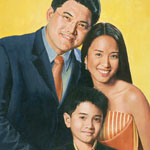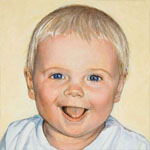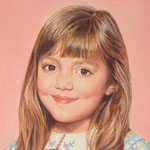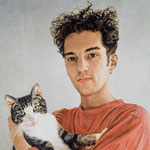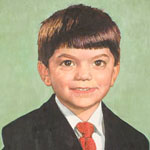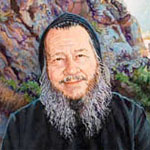Procedure
To me, the essence of a portrait is human expression. I believe the best kind of portrait catches that unique expression that makes you feel most alive with the person you’ve commissioned a portrait of.
I use every resource available to learn about beloved facial expressions and body language. This generally includes one or all of the following:
- Live interactions and sittings
- Photographs taken by me
- The client’s own favorite photographs
An important note about photography in portraiture
The tradition of the unsmiling, unengaged portrait subject comes from the days when the only expressions that could be painted were those a subject could hold for hours while the artist painted. Artists couldn’t paint any warm, spontaneous expression because no one can hold a natural-looking expression long enough for an artist to paint it.
Today, almost all portrait artists make use of photographs as they paint. But the esthetic of much fine art portraiture has nonetheless remained frozen in the past, as portraitists strive to camouflage their use of photography. I feel that contemporary portraits should embrace the fact that we can now paint the lively, fleeting expressions that photography helps us capture.
Yet a painted portrait is not just a copy of a photograph. A tremendous amount of artistry and technical skill is involved in creating a gorgeous work of art from what may be hazy or otherwise inferior snapshots. Countless decisions about color, composition, elimination of extraneous details, and many other elements, along with the technical skill to implement them, are all crucial to creating a beautiful portrait.
A painted portrait is a work of art that can be displayed anywhere, including in the most public rooms in one’s home where one might not hang a photograph.
Because each subject has their own unique personality, I do not have a one-size-fits-all procedure. Some people feel very natural while an artist paints them, or in front of an artist’s camera. Others only come most alive among people they love.
Ideally I want to meet, interact with, observe, and draw the subject from life. Sometimes this is not workable. If you have favorite photographs that you feel most capture the subject’s facial expressions or body language, I want to study them. This is true even if the photos’ lighting, focus, background, or clothing are imperfect. For me, the most important element is expression, and expression is sometimes so fleeting that it is only caught in a quick snapshot. I will take additional photographs and use other means to add the visual information I need to complete the portrait.
Generally the client and I choose one basic photograph as the basis of the overall composition. Under certain circumstances, I can combine more than one photograph and/or live drawing, especially when this only involves alteration of background. (Light sources and other elements must match precisely in order to make this work successfully.)
Setting, Background, Clothing
I like to see my subjects in their own environments, wearing clothing they feel themselves in. I want to use every element of each painting – including clothing and background – to capture the uniqueness of that very special person. I don’t generally pose subjects formally in my own controlled environment. I’m not interested in how a subject looks interacting with me – a stranger to them – or how they look under my lights in my studio, which has little to do with their lives. I do sometimes alter colors of clothing or other small details, in order to produce the most beautiful painting possible.
My Technique
My technique involves intense visual study deep into the layers of light and shadow in each person’s face. I paint with tiny brushes in acrylic, which dries quickly, so I can paint many layers of light and shadow. Some areas of my paintings have 20, 30, or more very thin layers of paint of varying shades. The fact that you’re seeing multiple layers of color overlapping in different ways is what gives the vivid, “alive” effect even though the surface of the painting appears virtually flat.

